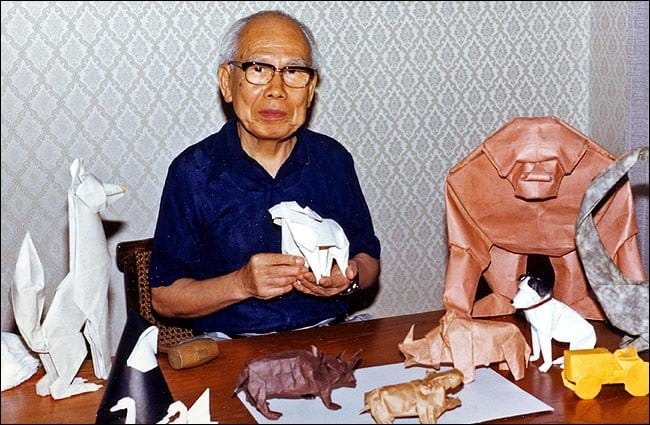
Akira Yoshizawa was born on March 14, 1911, in Kaminokawa, Tochigi, Japan. Growing up in a farming family, Yoshizawa moved to Tokyo at the age of 13 to work in a factory. It was during this time that he began to explore origami, a craft he had been introduced to in kindergarten. Despite the initial recreational nature of his folding, it laid the foundation for his future contributions to the art. Yoshizawa’s early experiences, marked by economic hardship and self-education, shaped his innovative approach to origami, transforming traditional patterns into expressive, three-dimensional art.
Initial Interest in Origami

Akira Yoshizawa’s interest in origami was sparked in his childhood, but it blossomed during his employment at a tool factory in Tokyo. Tasked with teaching geometry to junior employees, he used origami to explain complex concepts. This experience reignited his passion for paper folding, leading him to delve deeper into the craft during his spare time. In the 1930s, Yoshizawa made a bold decision to pursue origami full-time, a move that was initially met with financial struggle. However, his dedication and innovative spirit eventually led to recognition, setting the stage for his groundbreaking contributions to the world of origami.
Innovations in Folding Techniques
Akira Yoshizawa revolutionized origami with his innovative folding techniques, fundamentally transforming the craft from a simple pastime into a sophisticated art form. Before Yoshizawa, origami designs were relatively simplistic, primarily created from a series of basic folds without much emphasis on expression or realism. Yoshizawa introduced the concept of wet-folding, a technique that involves slightly dampening the paper to allow for more sculptural and rounded forms, enabling the creation of models with a sense of depth and vitality that had not been seen before.
Additionally, Yoshizawa pioneered the use of cutting and gluing in certain instances, which, while controversial, allowed for a greater range of artistic expression within the origami community. His approach to folding was deeply intuitive, often eschewing mathematical precision in favor of a more organic, exploratory process. This allowed him to create thousands of original models that were characterized by their lifelike qualities and emotional expressiveness, including his famous butterflies and other animals that seemed to embody the essence of the creatures they represented.
Yoshizawa’s techniques encouraged origami practitioners to view paper folding as a means of artistic expression, rather than merely a series of technical exercises. His work demonstrated that origami had the potential to be as rich and varied as any other art form, influencing countless artists and leading to the development of new styles and methods of folding. Through his innovations, Yoshizawa not only expanded the boundaries of what could be achieved with paper but also elevated origami to a globally respected art form.
Creation of the Yoshizawa-Randlett System
The Yoshizawa-Randlett system is a significant contribution to the world of origami, serving as a universal standard for origami instructions that bridged cultural and linguistic gaps among enthusiasts worldwide. Prior to this system, origami patterns were often conveyed through complex textual instructions or simple diagrams, which varied greatly in style and clarity, making it difficult for folders of different backgrounds to follow. In the 1950s, Akira Yoshizawa began developing a set of symbols and diagrams to represent folding actions clearly and succinctly, such as mountain and valley folds, which became foundational to the system.
British origamist Samuel Randlett and American origamist Robert Harbin later collaborated with Yoshizawa, refining and promoting the use of these symbols. The Yoshizawa-Randlett system was formally introduced in the 1960s, featuring a standardized set of diagrams and symbols that could be easily understood regardless of the folder’s native language. This system includes symbols for basic folds, reverse folds, pleats, sinks, and other origami techniques, allowing for complex models to be broken down into a series of understandable steps.
The adoption of the Yoshizawa-Randlett system facilitated the sharing of origami designs and techniques across different countries and cultures, significantly contributing to the global spread of origami. It enabled folders to learn from each other more efficiently and helped to preserve traditional models while also encouraging innovation and creativity in the art form. The system remains in use today, a testament to its effectiveness and Yoshizawa’s lasting impact on the origami community.
Artistic Achievements
Akira Yoshizawa’s artistic achievements in origami were groundbreaking, bringing the craft into the realm of fine art. His models were not just technically impressive; they were imbued with a sense of life and emotion. Yoshizawa’s ability to capture the essence of his subjects, from animals to flowers, using only paper, was unparalleled. His work was exhibited globally, in prestigious venues such as galleries and museums, showcasing the potential of origami as an expressive art form. These exhibitions not only highlighted his mastery but also inspired a new generation of artists to explore the creative possibilities of paper folding.
Prolific Output and Publications
Throughout his life, Akira Yoshizawa created more than 50,000 models, a testament to his prolific talent and dedication to origami. He documented thousands of these designs, contributing significantly to the body of knowledge in the field through numerous books and articles. His publications, which include detailed instructions and the philosophy behind his folding techniques, have educated and inspired countless origami enthusiasts worldwide. Yoshizawa’s work in publishing helped to disseminate his innovative techniques and philosophies, ensuring his lasting impact on the art of origami.
Educational Contributions
Akira Yoshizawa was deeply committed to education, believing that origami could enrich lives by enhancing mental well-being and fostering creativity. He conducted workshops and demonstrations across the globe, sharing his skills and passion for origami with people of all ages. Yoshizawa’s teaching emphasized the therapeutic and educational aspects of origami, including its ability to improve concentration, patience, and spatial visualization skills. His efforts greatly contributed to the popularization of origami as a tool for learning and personal development.
Influence and Legacy
The influence and legacy of Akira Yoshizawa extend far beyond his lifetime. He is widely regarded as the father of modern origami, having inspired a global movement of artists and enthusiasts who continue to explore and expand the boundaries of paper folding. Yoshizawa’s innovations, particularly his expressive models and folding techniques, have become foundational to contemporary origami practice. His legacy is also preserved through the International Origami Society, which he founded, continuing his mission to promote origami around the world.

Recognition and Honors
Throughout his career, Akira Yoshizawa received numerous awards and honors in recognition of his contributions to art and culture. In 1983, he was awarded the Order of the Rising Sun, one of Japan’s highest honors, for his cultural contributions. His work has been celebrated internationally, with exhibitions and collections in major museums and cultural institutions, cementing his status as a leading figure in the world of origami. These accolades reflect the global appreciation for his life’s work and his enduring impact on the art form.

